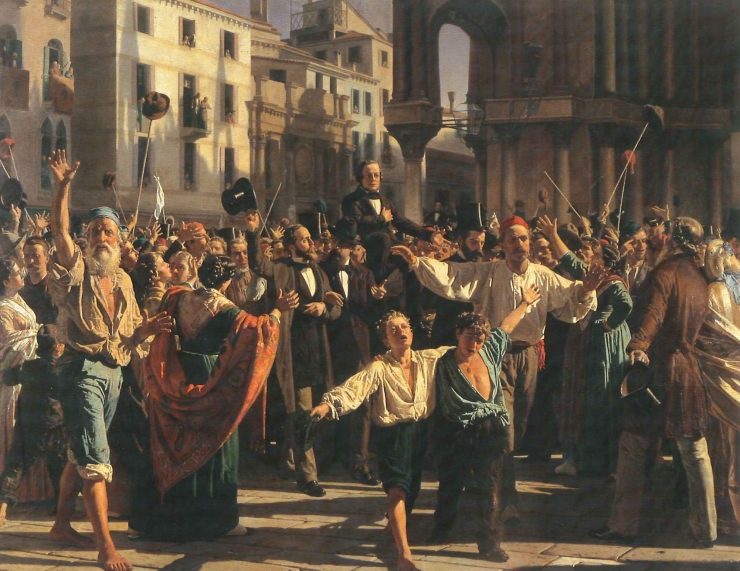
October 23, 2014, by Harry Cocks
The Habsburg Empire and Italian Nationalism, 1815-66
The Habsburg Empire that was finally extinguished in 1918 was made up of numerous nationalities. The national sentiment that developed within the Empire’s various national groupings in the nineteenth century is usually seen as a force for division within that empire, leading first to the independence of Italy between 1859 and 1870, and ultimately to the Empire’s dissolution (the traditional view can be seen top right in Napoleone Nani’s painting of Daniele Manin proclaiming the Venetian republic in 1848 (1874-6). But did nationalism in places like Italy break up the Habsburg Empire, or actually help Austria to rule? In a new article, “Foreign Rule? Transnational, national, and local perspectives on Venice and Venetia
within the ʻmultinationalʼ empire,” David Laven of Nottingham History and Laura Parker of Manchester University re-examine the so called “seconda dominazione” of Austrian rule in Lombardy and Venetia between 1814 and 1866. This period is often presented as one in which Austrian tyranny tried to crush nascent Italian nationalism, but this is a misconception, the authors suggest. In fact, Laven and Parker argue, national sentiment within the Empire in this period was half-formed, not that popular, and in any case often overwritten by transnational identities such as Catholicism. In contrast to earlier histories that saw the Austrians as oppressors, in Habsburg Lombardy and Venetia after 1815 the emperor Francis I actively tried to cultivate a sense of cultural italianità as a political tool. Unlikely as it seems, even his chancellor, Metternich – usually seen as the hammer of nationalists across continental Europe – wanted to encourage a common Italian cultural identity. Metternich floated the idea of an Italian federation along the lines of its German counterpart, and also established the journal Biblioteca Italiana as vehicle for literature and cultural debate. In Venice, historians usually see the development of local pride in the 1840s and ’50s as a counterweight to Austrian domination. But a series of cultural events and organisations usually taken to be symbolic of that resistance were in fact fostered and encouraged by its Austrian rulers. For instance, the foundation of the Panteon Veneto in 1847 to celebrate key intellectual figures from Venice, and the 9th Congress of Italian Scientists in the same year not only promoted local pride but also drew in figures from across Italy. Far from undermining these efforts, the Veneto’s Austrian rulers welcomed this expression of the city’s republican history, aiming to yoke Italian culture to the larger Habsburg whole. In this way the Austrians tried to create an imperial ethos that celebrated rather than suppressed local cultures. This was even true under the emperor Franz Joseph who was much more noticeably German than Francis I (who grew up in Tuscany). The result was that, when in 1866 the Prussian victory over Austria led to the loss of Venetia, the reaction in Venice itself was muted, and celebration of unification short-lived. Less than a decade later, when Franz Joseph visited his former possession, Venetian crowds welcomed him enthusiastically. During their rule the Austrians had recognised and cultivated Venice’s cultural and historical distinctiveness, respecting the Venetians both as Italians and Venetians. After Italian unification nationalism had to be yoked to this existing local and municipal culture. It had to accommodate itself to a sense of the local that had always been acknowledged and fostered by the Austrians.
No comments yet, fill out a comment to be the first

Leave a Reply